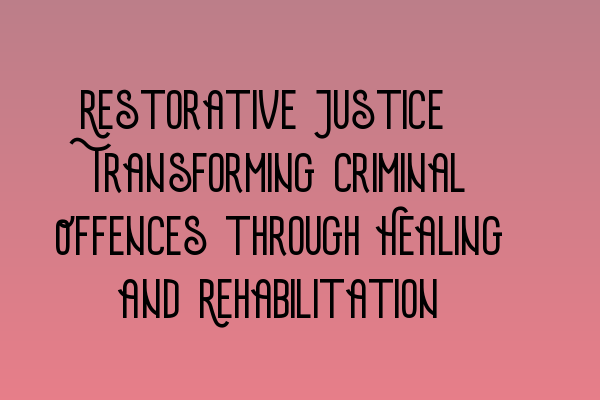Restorative Justice: Transforming Criminal Offences through Healing and Rehabilitation
In the realm of criminal law, punishment has traditionally been the primary focus when dealing with offenders. However, a growing movement towards restorative justice aims to shift the paradigm by prioritizing healing and rehabilitation. This approach recognizes that punishment alone may not lead to meaningful change or address the underlying issues that contribute to criminal behavior.
The Concept of Restorative Justice
Restorative justice is a philosophy and approach that emphasizes repairing the harm caused by criminal offenses through dialogue, empathy, and community involvement. It seeks to address the needs and concerns of all parties involved – the victim, the offender, and the community at large.
Instead of viewing crime solely as a violation of the state, restorative justice acknowledges that it also harms individuals and communities. It recognizes that offenders have a responsibility to make amends and that victims have a right to be heard, supported, and receive restitution.
The Benefits of Restorative Justice
Restorative justice offers several advantages over traditional punitive approaches. Firstly, it allows victims to have a voice and actively participate in the resolution process. By providing a safe space for victims to express their emotions and concerns, it can promote healing and closure.
Secondly, restorative justice focuses on holding offenders accountable for their actions while providing them with opportunities for rehabilitation. Through face-to-face dialogues and mediated discussions, offenders can confront the consequences of their behavior and gain insights into the impact it has had on others.
This process often leads to increased empathy and self-reflection, which can be crucial for breaking the cycle of criminal behavior. Additionally, it encourages offenders to take responsibility for repairing the harm caused, both to the individual victim and the broader community.
Implementing Restorative Justice
Restorative justice can be implemented in various stages of the criminal justice system, from pre-trial to post-conviction. It may involve victim-offender mediation, family group conferences, or community reparative boards. These restorative processes aim to empower victims, encourage offender accountability, and foster community involvement.
However, it is important to note that restorative justice is not a one-size-fits-all solution. It requires trained facilitators, adequate resources, and a supportive legal framework to ensure its effectiveness. Furthermore, the success of restorative justice relies on the willingness of all parties involved to actively engage in the process.
Conclusion
Restorative justice offers a progressive and holistic approach to criminal offenses. By prioritizing healing, rehabilitation, and community involvement, it has the potential to transform the traditional punitive model. As society continues to evolve, exploring alternative approaches to criminal justice becomes increasingly essential.
If you would like to learn more about criminal law and practice in the UK, check out these related articles:
- Demystifying the Solicitors Qualifying Examination Format
- LLC Formation Made Simple: Step-by-Step Guide for UK Entrepreneurs
- LLC Formation: A Step-by-Step Guide for UK Entrepreneurs
- Business Regulations in the UK: A Comprehensive Overview
- Decoding Corporate Structures: A Comprehensive Legal Insight
